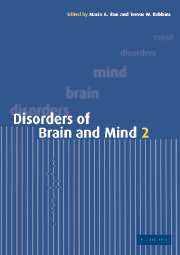Book contents
- Frontmatter
- Contents
- List of contributors
- Preface
- Part I Genes and behaviour
- Part II Brain development
- Part III New ways of imaging the brain
- Part VI Imaging the normal and abnormal mind
- 7 Functional neuro-imaging and models of normal brain function
- 8 Functional magnetic resonance imaging in psychiatry: where are we now and where are we going?
- 9 Positron emission tomography (PET) neurochemistry: where are we now and where are we going?
- Part V Consciousness and will
- Part IV Recent advances in dementia
- Part VII Affective illness
- Part VIII Aggression
- Part IX Drug use and abuse
- Index
- Plate section
- References
9 - Positron emission tomography (PET) neurochemistry: where are we now and where are we going?
from Part VI - Imaging the normal and abnormal mind
Published online by Cambridge University Press: 19 January 2010
- Frontmatter
- Contents
- List of contributors
- Preface
- Part I Genes and behaviour
- Part II Brain development
- Part III New ways of imaging the brain
- Part VI Imaging the normal and abnormal mind
- 7 Functional neuro-imaging and models of normal brain function
- 8 Functional magnetic resonance imaging in psychiatry: where are we now and where are we going?
- 9 Positron emission tomography (PET) neurochemistry: where are we now and where are we going?
- Part V Consciousness and will
- Part IV Recent advances in dementia
- Part VII Affective illness
- Part VIII Aggression
- Part IX Drug use and abuse
- Index
- Plate section
- References
Summary
Introduction
A basic neuroscientist reading about ‘brain functional mapping’ might be forgiven for thinking all PET-based (positron emission tomography) investigations of brain function have been superseded by functional magnetic resonance imaging (fMRI). Nothing could be further from the truth. Certainly, in many circumstances fMRI is replacing PET for imaging regional cerebral blood-flow changes induced by cognitive tasks – the basis of brain functional mapping paradigms where blood flow is used to index neuronal activation (Raichle 1987). However, brain PET is first and foremost a technique for imaging neurochemistry in the living brain (Pike 1993; Grasby et al. 1996; Grasby 2000). As such it is unrivalled in the potential diversity of imageable neurochemical targets and the sensitivity of detection. Neurochemical targets can be measured at very low concentrations with PET; thus many central nervous system (CNS) receptor systems, typically at concentrations of nmoles/g or pmoles/g tissue, can be investigated.
PET methodology and application to psychiatry
PET is a technologically and financially demanding tool, which has restricted its widespread application in the UK, although there are estimated to be over 250 PET centres worldwide. Briefly, a successful PET programme requires a flexible medical cyclotron to produce short-lived radioisotopes, particularly 11C, 18F and 15O. In addition, an adequate automated radiochemistry resource is necessary to incorporate these short-lived radioisotopes into molecules of biological interest that can be injected into humans at subpharmacological ‘tracer’ doses (typically microgram amounts). These positron-emitting radiotracers are typically high-affinity, selective antagonists for receptors or substrates for specific enzymes.
- Type
- Chapter
- Information
- Disorders of Brain and Mind , pp. 181 - 194Publisher: Cambridge University PressPrint publication year: 2003

